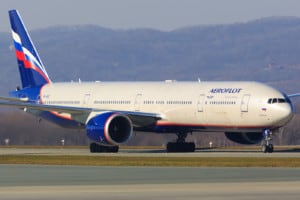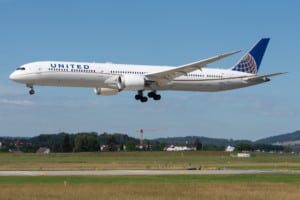For aviation enthusiasts, the 787 vs 777 debate has been an ongoing discussion. While both planes have several commonalities, they also have distinct differences.
This debate is ultimately driven by the fact that they are two of the most successful and popular aircraft models ever produced. To truly understand the differences, let’s look at each model separately.
| Aircraft: | Boeing 777-300 | Boeing 787-10 Dreamliner |
|---|---|---|
| Photo: |
 |
 |
| Country: | United States | United States |
| Manufactured: | from: 1997 to: 2006 | from: 2015 to: Present |
| ICAO: | B773 | B78X |
| Price: | $279 million | $338.4 million |
| Avionics: | Honeywell Avionics | Rockwell Collins next generation avionics |
| Engine: | 2x Rolls Royce RR-892 or Pratt & Whitney 4098 or GE90-94B | 2x Rolls-Royce Trent 1000 or General Electric GEnx-1B |
| Engine Type: | Turbofan | Turbofan |
| Power: | 98,000 pound-force | 76,000 pound-force |
| Max Cruise Speed: |
510 knots 945 Km/h |
515 knots 954 Km/h |
| Approach Speed (Vref): | 149 knots | 140 knots |
| Travel Range: |
6,030 Nautical Miles
11,168 Kilometers |
6,430 Nautical Miles
11,908 Kilometers |
| Fuel Economy: |
0.13 nautical mile / gallon 0.064 kilometres / litre |
0.22 nautical mile / gallon 0.108 kilometres / litre |
| Service Ceiling: | 43,100 feet | 43,000 feet |
| Rate of Climb: |
3000 feet / minute 15.24metre / second |
3000 feet / minute 15.24metre / second |
| Take Off Distance: |
3230 metre 10,596.98 feet |
2800 metre 9,186.24 feet |
| Landing Distance: |
1800 metre 5,905.44 feet |
1520 metre 4,986.82 feet |
| Max Take Off Weight: |
299,370 Kg 659,991 lbs |
254,011 Kg 559,993 lbs |
| Max Landing Weight: | - |
201,848 Kg 444,994 lbs |
| Max Payload: |
66,770 Kg 147,201 lbs |
57,277 Kg 126,273 lbs |
| Fuel Tank Capacity: |
45,220 gallon 171,176 litre |
33,399 gallon 126,429 litre |
| Baggage Volume: |
200 m3 7,063 ft3 |
190.3 m3 6,720 ft3 |
| Seats - Economy: | 550 seats | 440 seats |
| Seats - Business Class: | 451 seats | 290 seats |
| Seats - First Class: | 368 seats | - |
| Cabin Height: |
2.2 metre 7.22 feet |
2.5 metre 8.20 feet |
| Cabin Width: |
5.86 metre 19.23 feet |
5.49 metre 18.01 feet |
| Cabin Length: |
59.24 metre 194.35 feet |
62 metre 203.41 feet |
| Exterior Length: |
73.9 metre 242.45 feet |
68.3 metre 224.08 feet |
| Tail Height: | 18.5 metre - 60.69 feet | 17.02 metre - 55.84 feet |
| Fuselage Diameter: |
6.19 metre 20.31 feet |
5.77 metre 18.93 feet |
| Wing Span / Rotor Diameter: |
60.9 metre 199.80 feet |
60.12 metre 197.24 feet |
| Wing Tips: | No Winglets | Raked Wingtips |
| More Info: | Boeing 777-300 | Boeing 787-10 Dreamliner |
|
Data presented is for entertainment purposes and should not be used operationally.
|
Other Boeing 777-300 comparisons:
Other Boeing 787-10 Dreamliner comparisons:
About the Boeing 777-300
The Boeing 777 is a wide-body and long-range aircraft built and created by Boeing Commercial Airplanes. It also features an advanced flight deck design, allowing for greater crew comfort and efficiency.
Why was it developed and built?
It was built in discussions with eight main airlines to replace older wide-body airliners. As Boeing’s first fly-by-wire airliner, the Boeing 777 introduced several novel systems for use on aircraft.
What purpose does it serve?
The Boeing 777 is used for long-haul flights, with the longest scheduled nonstop flight operating at a range of 8,555 nautical miles. It is also used for short-haul and medium-haul flights when a larger capacity plane is needed.
About the Boeing 787-10 Dreamliner
Think of the Boeing 787 Dreamliner as a flying oasis. It has been designed with passenger comfort in mind, boasting larger windows and more ambient light and featuring advancements in air quality, climate control, and filtration.
Why was it developed and built?
The plane is made mostly of lightweight composite materials, which makes it more fuel-efficient than other aircraft. It also has larger windows and lower cabin pressure, which makes for a more comfortable flight.
Additionally, the Boeing 787 Dreamliner is equipped with advanced technologies that make it quieter and more efficient. For example, it uses electric motors to power some of its systems, and its engines are designed to minimize noise and vibration.
What purpose does it serve?
The Boeing 787 Dreamliner is used for long-distance flights and can fly nonstop distances of up to 8,555 nautical miles. Moreover, it is also used for medium and long-haul flights when a larger plane is needed.
How are the Boeing 777 and Boeing 787 Dreamliner different?
The Boeing 777 and Boeing 787 Dreamliner are two of the most famous planes in the sky. Though they’re both made by Boeing, these two planes are pretty different.
Here’s a look at how the Boeing 777 and Boeing 787 Dreamliner differ regarding range, fuel efficiency, and passenger capacity.
Range
The Boeing 777 has a range of 5,240 – 8,555 miles, while the Boeing 787 Dreamliner ranges from 7,355 to 6,430 miles.
This range difference is because the Boeing 777 is a larger plane; it can carry more fuel than the Boeing 787 Dreamliner. As a result, the Boeing 777 can fly for longer periods without stopping to refuel.
Fuel Efficiency
The Boeing 777 is also more fuel efficient than the Boeing 787 Dreamliner. The Boeing 777 burns less fuel than comparable planes.
This efficiency is partly due to its size; because it’s a larger plane, it can take advantage of economies of scale. The Boeing 787 Dreamliner is also more fuel efficient than older models, but it doesn’t quite match up to the Boeing 777 in this area.
Passenger Capacity
The Boeing 777 can seat between 301 and 368 passengers, while the Boeing 787 Dreamliner can seat between 240 and 330 passengers.
Again, this difference is because the Boeing 777 is a larger plane with more passenger space. However, because the Boeing 787 Dreamliner uses newer technology, it feels more spacious inside despite having fewer seats.
Speed
The Boeing 777 and Boeing 787 Dreamliner also differ in terms of speed. The Boeing 777 has a cruise speed of 892 km/h, while the Boeing 787 Dreamliner cruises at 903 km/h. This is because the Boeing 777 has more powerful engines and a larger wingspan than the 787.
Ultimately, the Boeing 777 and 787 Dreamliner are two of the most popular aircraft in the sky.
How are the Boeing 777 and Boeing 787 Dreamliner similar?
Despite their differences, the 777 and 787 share many similarities.
- Both planes are made of advanced composite materials that make them lighter and more fuel efficient than older models.
- Additionally, both planes feature advanced avionics technology, such as fly-by-wire systems and digital cockpits.
- Finally, both planes have been produced in multiple variants with different engine configurations.
Both planes have been incredibly successful, but they serve different purposes, depending on the airline’s or customer’s needs. The Boeing 777 is larger, more fuel efficient, and longer ranged than the Boeing 787 Dreamliner. On the other hand, the Boeing 787 Dreamliner feels more spacious!
What’s better about the Boeing 777?
The Boeing 777 is a long-range, wide-body twin-engine airplane built by Boeing Commercial Airplanes.
- It is the world’s largest twinjet and has a typical seating capacity for 314 to 451 passengers, ranging from 5,235 to 9,380 nautical miles.
- The Boeing 777 is identifiable by its large-diameter fuselage and unique hinged tail fin, which provide greater strength and durability.
As a result, the Boeing 777 provides an enjoyable and efficient flying experience for passengers and crew.
What’s better about the Boeing 787 Dreamliner?
The Boeing 787 Dreamliner is a fuel-efficient wide-body jet airliner. It is made mostly of composite materials.
- The airplane is quieter and cooler, with bigger windows and larger overhead bins. Likewise, the air inside the cabin is also cleaner and less dry.
- Moreover, the airplane automatically maintains the ideal cabin humidity level to reduce the possibility of dehydration and jet lag.
- Likewise, it uses less fuel than similar-sized airplanes. It produces fewer carbon emissions, making it more environmentally friendly.
In short, the Boeing 787 Dreamliner is a superior aircraft in terms of fuel efficiency, passenger comfort, and environmental friendliness.
Conclusion
In conclusion, the 787 vs 777 debate is ultimately driven by their commonalities and differences. If you’re looking for nonstop service to your destination, the Boeing 777 is probably your best bet.
But if you’re looking for a more comfortable flight experience, you might prefer flying on the Boeing 787 Dreamliner. No matter your chosen plane, you will surely have a safe and enjoyable flight.


